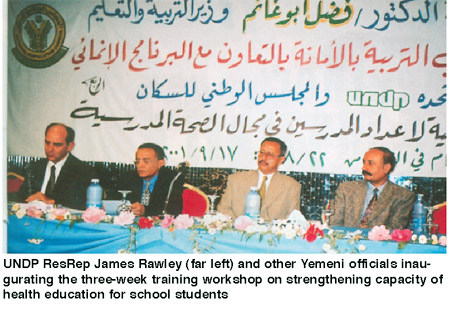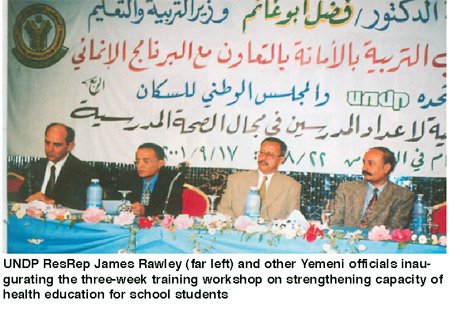
HIV/AIDS: A Silent Threat in Yemen [Archives:2002/03/Health]
January 14 2002

Mohammed Hatem Al-Qadhi
[email protected]
Lack of surveillance and reporting in Yemen has made it difficult to estimate the magnitude of HIV/AIDS in the country. The younger population, aged 20-49, appears to be the most affected by the epidemic. Commercial sex workers, illegal in the country, have also been hit hard; HIV rates of seven percent among those identified by police have been reported.
Discussion of sexual matters in Yemen is generally taboo. Little is known about the prevalence of extramarital sex or the use of condoms, which could prevent transmission of HIV. Official data indicates a low rate of HIV infection in this country of 18.7 million. By the end of 2000, only 960 HIV positive cases had been reported.
According to a HIV/AIDS Situation and Needs Assessment Report released by the United Nations Development Program (UNDP) in June 2001, because AIDS is largely under-diagnosed, and health services are limited, we see only the tip of the iceberg.
The health system in general is weak says James Rawley, UNDP Resident Representative in Yemen. We cannot focus exclusively on HIV/AIDS. We have to work with many partners to improve the health system at large. We must also help create the conditions for sustained economic growth, so that the country has more resources to invest in better health
Underground cases
UNDP is helping to plan an appropriate strategy to counter HIV/AIDS.
The World Health Organization (WHO) estimates that behind each reported case of HIV infection in Yemen, 15 others are underground or hidden. Unofficial reports suggest over 5,000 cases in all. Risk factors include inadequate monitoring and screening of blood donations and transfusions, and lack of trained health workers and laboratory facilities. Other contributing factors include rural-urban migration, poverty, illiteracy and unemployment.
Yemen is host to some 60,000 refugees. The majority are Somalis, followed by Eritreans and Ethiopians. Some live in camps and others are scattered in the cities. Sexually-transmitted diseases (STDs) among refugees could be an additional factor in spreading HIV.
We are working in Yemen on two levels, advocacy and public awareness Rawley said. IN addition, we are helping authorities conduct scientific studies and surveys to get a better grip on the extent of the epidemic at this time.
The Joint United Nations Program on HIV/AIDS (UNAIDS) and UNDP allocated US$227,000 to support HIV/AIDS awareness campaigns in Yemen for 2000-2001. UNDP has also organized major workshops, in collaboration with WHO, to educate the public about how HIV/AIDS is spread.
A growing concern
Following the HIV/AIDS Situation and Needs Assessment Report, which focuses on the city of Sana’a, UNDP, WHO, UNAIDS and the Government of Yemen will carry out surveys in a number of major urban centers, including Taiz and Hodeidah in the North, Aden in the South, and Hadhramout in the Eastern region, to get a better grasp of the disease in the country.
I am quite confident that if the Yemeni authorities come up with a comprehensive plan based on the best scientific information available, done in a participatory way, UNDP can convince the international community that it should be supported Rawley said.
A number of senior government officials have attended HIV/AIDS awareness events. This is important, Rawley noted, because there remains a wide range of misconceptions about how HIV/AIDS is transmitted and how to treat persons who are HIV positive.
UNDP held two school exhibitions of photographs in Sana’a in March 2000. UNDP also provided technical assistance to a mobile theatre launched by Partners for Development (PAD), an international non-governmental organization, in May and June 2001. We were assisted by UNDP in developing our plans said Cindy Issac, PAD coordinator. The troupe has spread 30 HIV-awareness messages throughout the country.
UNDP and UNAIDS have also carried out surveys on the question of STDs in a Yemeni prison. Six HIV positive cases were found, out of 2,922 tested in the Sana’a Central Prison last year. In addition, UNDP supports a monthly newspaper called AIDS.
In August, a three-week training workshop was launched to strengthen health education and HIV/AIDS awareness among schools. The event was sponsored by the Education Bureau in Sana’a with support from UNDP. We have 2.8 million students in the primary and secondary education system, and such activities will certainly be of great help to them Said Dr. Abdulaziz Habtoor, Yemens Vice Education Minister.
The emphasis in Yemen, Rawley said, is on catching the epidemic while it is still at an early stage. Otherwise, it will get out of hand because the conditions that help spread the epidemic exist here.
This report has been taken from CHOICES Magazine published by UNDP in USA, December, 2001
——
[archive-e:03-v:2002-y:2002-d:2002-01-14-p:./2002/iss03/health.htm]


